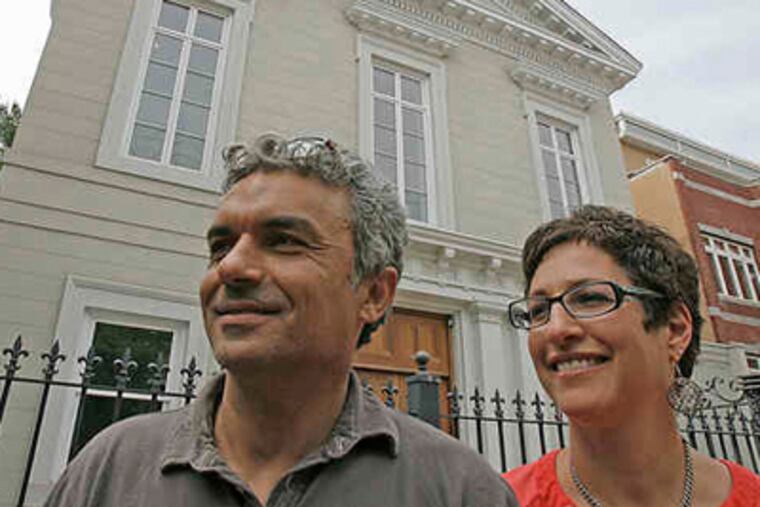Daniel Rubin: Historic, hip house with a couple of downsides
By the time Isaac Ohayon was ready for the Lombard Central Presbyterian Church, the church was no longer ready for him. Once before the Moroccan-born, Israeli-trained builder had had his hands on the property.

By the time Isaac Ohayon was ready for the Lombard Central Presbyterian Church, the church was no longer ready for him.
Once before the Moroccan-born, Israeli-trained builder had had his hands on the property, built in the heart of Philadelphia's African American community in 1850.
Fifteen years ago, the vacant church was headed to sheriff's sale. For $35,000 Ohayon and his wife, Naomi, could have owned the Greek Revival edifice.
"There were beautiful details left in the ceiling," says Ohayon, a soft-spoken 48-year-old with graying curls, a hole in his jersey, and wood dust on his boots. "The mezzanine was still there, some of the woodwork. I thought I could restore the original pieces and create this funky, lofty space."
But his business - Masada Custom Building - was only four years old, and he hadn't yet done many historic renovations around town. It was too big a project for the couple. Too soon.
In 2004, the Ohayons got a second chance. The price was steeper this time, $450,000 for the shell, and a shell it was.
Pigeons were the only congregants. Holes pitted the roof. The only salvageable pieces were elements on the facade and some massive wooden ceiling trusses. The Ohayons were still transfixed by the possibilities of the place.
A one-of-a-kind home is what they envisioned - the building's gutted 9,500 square feet filled with marble from Turkey, teak from Brazil, tiles from Italy, appliances from Germany.
Two things they didn't count on.
That by the time their construction was finished last summer, the market would be awful.
And that not everyone likes to live in a graveyard.
You might remember the story: Back in the summer of 2008, Ohayon and his crew were digging sanitation lines in front of the property at 832 Lombard when the blade of his shovel hit a slate slab.
The brick vault buried underneath appeared on none of his maps or surveys. He pried open the stone and at the bottom of the dark void lay some scraps of cloth, some antique buttons, and the bones of three people.
Ohayon called the city Historical Commission and learned he had a choice. He could leave his discovery be and continue work. Or he could dig into the bones' provenance. He decided to do both.
The couple didn't feel comfortable moving ahead. Several months and about $15,000 later, they learned what they had discovered was the resting place of the Rev. Stephen Gloucester, a former slave who founded the church and had paid a price for his abolitionist methods.
Gloucester had been permanently injured when a canal captain threw him overboard in New York state for daring to eat with white passengers. And in the race riots of 1842, Gloucester's first Philadelphia church was destroyed by a mob.
On Lombard Street, the father of nine chose a less visible path to opposing slavery. No abolitionist speeches boomed from the pulpit. In the end, Gloucester was denounced by Frederick Douglass for not doing more for the cause.
Buried with Gloucester was his wife, Ann. After some confusion, the last remains were revealed to belong to another pastor, the Rev. Benjamin F. Templeton.
The Ohayons tried to find a better place for the trio. Isaac talked with the current leaders of Lombard Presbyterian, which had moved to 42d and Powelton.
For decades congregants had wondered what had become of their founder. In a December 2008 ceremony, the Old Pine Church graveyard received the remains of the three. Church members and historic preservations have praised the Ohayons' commitment to putting the bodies to rest.
Douglas Mooney, an archaeologist who identified Gloucester's remains, says he thinks the Ohayons have done right by the building's former inhabitants.
"I have a feeling there's great karma there," Mooney said. "Stephen Gloucester was one seriously incredible individual. There's nothing there but good energy."
Even so, the property requires a special buyer. There's no question about the craftsmanship - it won a grand jury award last May from the Preservation Alliance of Greater Philadelphia.
The couple gave a quick tour of their love labor the other day, starting at a towering wall of apple wood harvested from the Golan Heights in Israel. They showed off the highly glossed tiger wood next to the Sub-Zero wine cooler, the opaque green glass basin in the powder room, a bold circle in a square that sits on a slab of African walnut.
"When I saw that, I said, 'I've got to have that,' " Isaac Ohayon said. "It's very pricey, but I bit my tongue."
The price tag for all this history and contemporary cool is considerable even in a bull market: $3.99 million. The Ohayons have yet to entertain a serious bid.
"It's unfortunate," he said. "Sometimes a beautiful piece can hurt you."